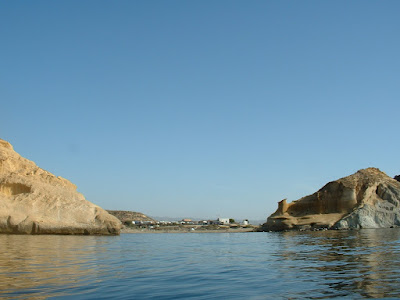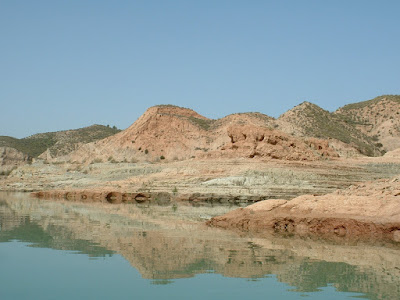Yesterday (Sunday November 27th.) I went back to Punta Parda, last visited a month ago (blog post 9/11/22), with The Twist. A shopping trip to Mojacar the previous day, with a look at the sea, had confirmed that after a long period of high winds conditions were looking pretty good for another kayak trip.
After launching in the lovely sheltered bay, Cala Cerrada, I paddled out into open water and round to Cala Taray to have a closer look at the cave rooms I saw on my previous visit. Of the three groups of man-made caves at Punta Parda this one is best reached by water.
A view of the interior from the entrance. From the opening on the left the floor slopes up to a hole in ground above. The arched alcove looks like a fireplace but there isn't a chimney nor any sign of smoke deposits. There is a near identical alcove at the back, past the dividing wall. Ceiling is low, standing room for short people only!
Outside the cave is this shallow lagoon. It transpires that these cave rooms were not storerooms for fishermen, as I first thought. but were used for storing esparto grass. Part of processing of esparto grass, for its use in paper making, was soaking it in sea water - hence the creation of a shallow lagoon.
Heading back towards Punta Parda.
From Cala Taray I had followed the beach southwards for a while, towards the town of San Juan de los Terreros, until a beach angler started jumping up and down and shouting at me (in Spanish, so I've no idea what he called me!). And I've no idea how he had managed to cast so far out and still have his line floating on the surface, to be picked up by my paddle. Anyway, he calmed down when he realized his rod wasn't going to get towed out to sea.

Conditions, hardly a breath of wind and barely any swell, were perfect for a lengthy paddle. So I rounded Punta Parta, through the nets and marker buoys still there, and headed across to an island, Isla Cama de los Novios, to the north of the headland. Not much of an island, just a very big rock really, inhabited by cormorants and seagulls - which all abandoned the island before I could take a photo! Had a closer look and did the necessary circumnavigation before a long, lazy paddle back to my starting point. Isla Cama de los Novios is a long name for a little island. The name doesn't translate easily - it literally means 'Bed of the Newlyweds Island' (or 'Honeymoon Island' perhaps?). Maybe there is more to this name!
Time on the water was 2¼ hrs. and distance paddled was 6.7 kilometres - fueled by fig rolls, wine gums and a small carton of a tropical fruits drink. There were a few people on the beach in the bay when I got back there at 1:15 p.m. but nowhere near as many as when I was there a month ago. Colder days have arrived.
After packing the kayak away I went to look at the cave storerooms in the bay, which can be reached by foot.
The inside of one part of the storerooms, which I saw soon after launching in the bay last month.
The doorways to these rooms are too high above beach level to scramble into and some are gated.
Very close too these storerooms was the remains of another of the man-made shallow lagoons. According to a bit of Google research these 'lagoons' were called 'cocedores'.
On the other side of the bay, nearer to the headland, there are more cave storerooms - too many to fit in the viewfinder. I didn't get close to these last time I was here, because there were crowds of young people near them. A coachload had arrived and they had chosen the shady spot outside these caves to congregate.
Looking into one of the cave store rooms. One where the gates had fallen off. Here the rooms were mainly bigger than any of the other locations I had been to.
At beach level outside these cave storerooms was the remains of another 'cocedores'.
According to the little we've found out so far about esparto grass, these cave storerooms date back to the 19th. century when the esparto grass trade was very important in this region of Spain. Esparto was used to make rope, twine, baskets, mats, soles for shoes and all manner of everyday items. It was even exported, in huge quantities, to England for the manufacture of quality paper - but it had to be damp ('fermenting' it said) before loading onto ships.
It had been an interesting, enjoyable and eventful kayaking day.







































